2014 Hyundai Santa Fe climate control
[x] Cancel search: climate controlPage 266 of 711
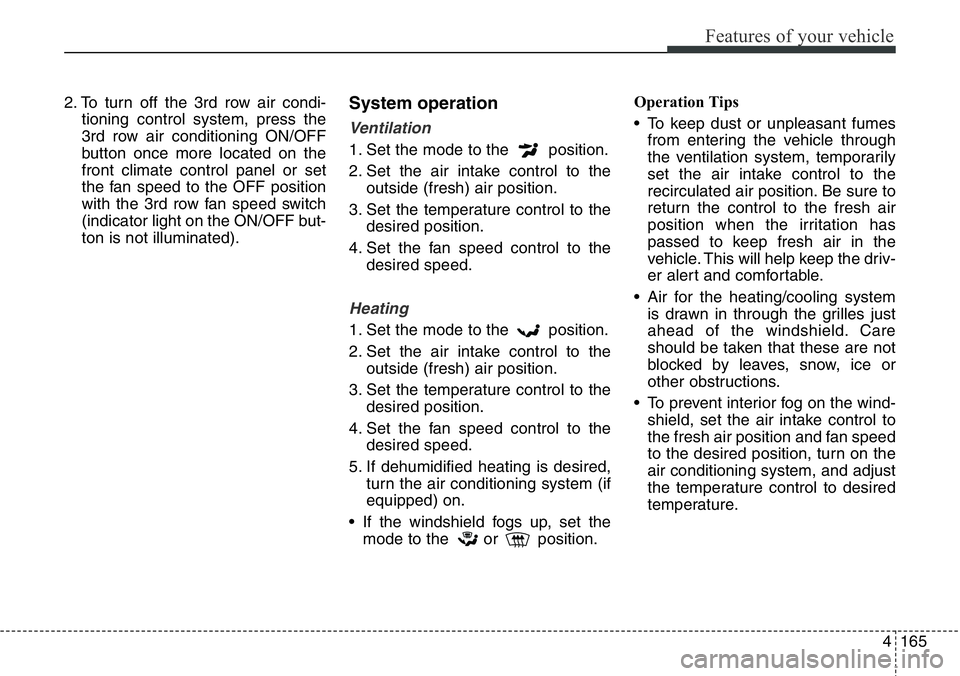
4165
Features of your vehicle
2. To turn off the 3rd row air condi-
tioning control system, press the
3rd row air conditioning ON/OFF
button once more located on the
front climate control panel or set
the fan speed to the OFF position
with the 3rd row fan speed switch
(indicator light on the ON/OFF but-
ton is not illuminated).System operation
Ventilation
1. Set the mode to the position.
2. Set the air intake control to the
outside (fresh) air position.
3. Set the temperature control to the
desired position.
4. Set the fan speed control to the
desired speed.
Heating
1. Set the mode to the position.
2. Set the air intake control to the
outside (fresh) air position.
3. Set the temperature control to the
desired position.
4. Set the fan speed control to the
desired speed.
5. If dehumidified heating is desired,
turn the air conditioning system (if
equipped) on.
• If the windshield fogs up, set the
mode to the or position.Operation Tips
• To keep dust or unpleasant fumes
from entering the vehicle through
the ventilation system, temporarily
set the air intake control to the
recirculated air position. Be sure to
return the control to the fresh air
position when the irritation has
passed to keep fresh air in the
vehicle. This will help keep the driv-
er alert and comfortable.
• Air for the heating/cooling system
is drawn in through the grilles just
ahead of the windshield. Care
should be taken that these are not
blocked by leaves, snow, ice or
other obstructions.
• To prevent interior fog on the wind-
shield, set the air intake control to
the fresh air position and fan speed
to the desired position, turn on the
air conditioning system, and adjust
the temperature control to desired
temperature.
Page 268 of 711
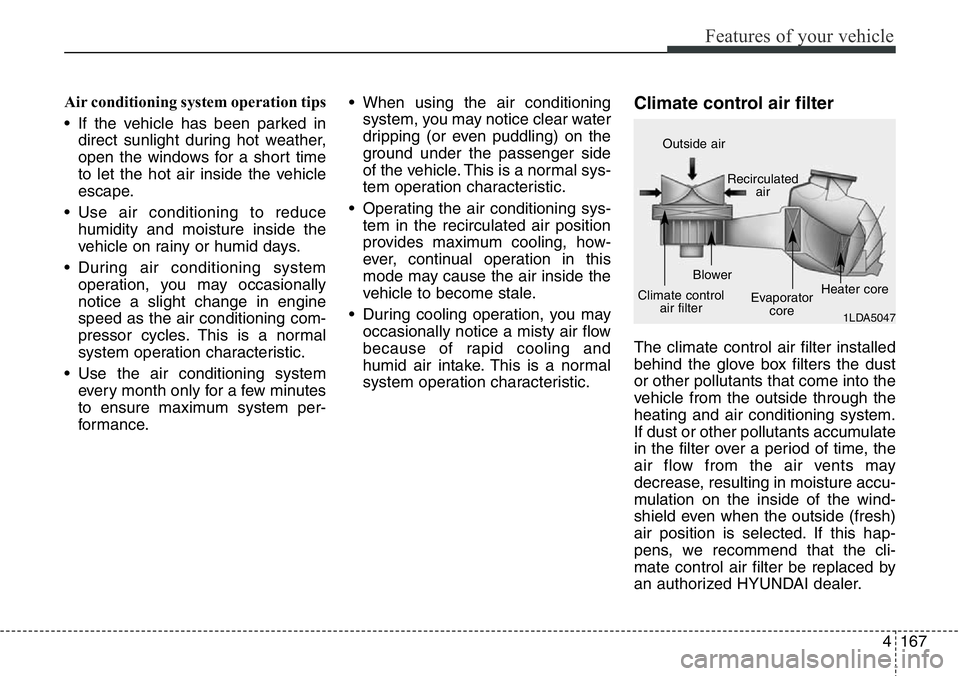
4167
Features of your vehicle
Air conditioning system operation tips
• If the vehicle has been parked in
direct sunlight during hot weather,
open the windows for a short time
to let the hot air inside the vehicle
escape.
• Use air conditioning to reduce
humidity and moisture inside the
vehicle on rainy or humid days.
• During air conditioning system
operation, you may occasionally
notice a slight change in engine
speed as the air conditioning com-
pressor cycles. This is a normal
system operation characteristic.
• Use the air conditioning system
every month only for a few minutes
to ensure maximum system per-
formance.• When using the air conditioning
system, you may notice clear water
dripping (or even puddling) on the
ground under the passenger side
of the vehicle. This is a normal sys-
tem operation characteristic.
• Operating the air conditioning sys-
tem in the recirculated air position
provides maximum cooling, how-
ever, continual operation in this
mode may cause the air inside the
vehicle to become stale.
• During cooling operation, you may
occasionally notice a misty air flow
because of rapid cooling and
humid air intake. This is a normal
system operation characteristic.Climate control air filter
The climate control air filter installed
behind the glove box filters the dust
or other pollutants that come into the
vehicle from the outside through the
heating and air conditioning system.
If dust or other pollutants accumulate
in the filter over a period of time, the
air flow from the air vents may
decrease, resulting in moisture accu-
mulation on the inside of the wind-
shield even when the outside (fresh)
air position is selected. If this hap-
pens, we recommend that the cli-
mate control air filter be replaced by
an authorized HYUNDAI dealer.
1LDA5047
Outside air
Recirculated
air
Climate control
air filterBlower
Evaporator
coreHeater core
Page 271 of 711
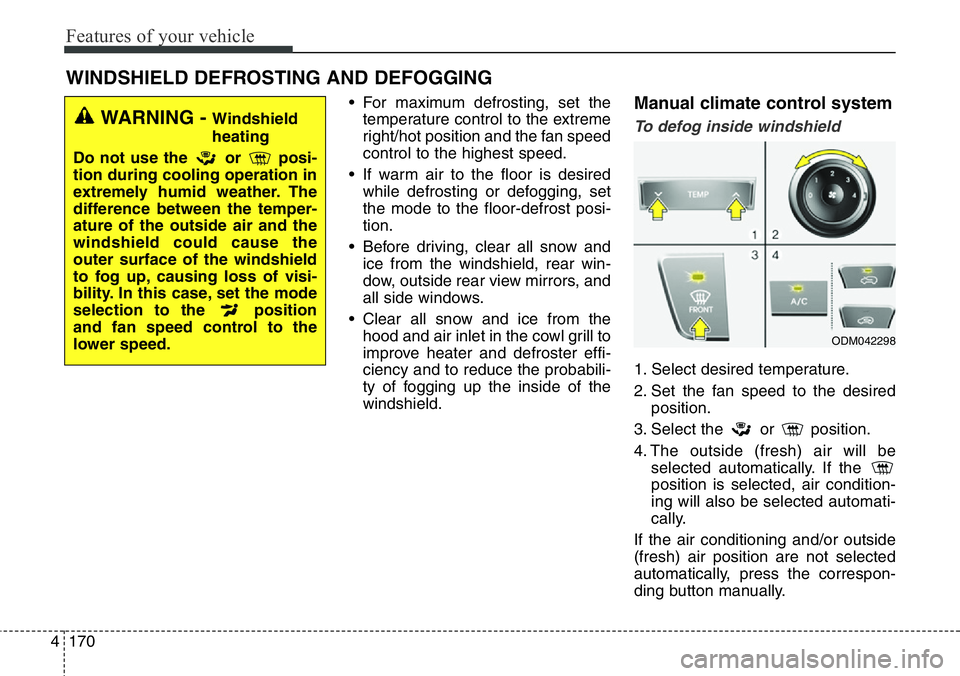
Features of your vehicle
170 4
• For maximum defrosting, set the
temperature control to the extreme
right/hot position and the fan speed
control to the highest speed.
• If warm air to the floor is desired
while defrosting or defogging, set
the mode to the floor-defrost posi-
tion.
• Before driving, clear all snow and
ice from the windshield, rear win-
dow, outside rear view mirrors, and
all side windows.
• Clear all snow and ice from the
hood and air inlet in the cowl grill to
improve heater and defroster effi-
ciency and to reduce the probabili-
ty of fogging up the inside of the
windshield.Manual climate control system
To defog inside windshield
1. Select desired temperature.
2. Set the fan speed to the desired
position.
3. Select the or position.
4. The outside (fresh) air will be
selected automatically. If the
position is selected, air condition-
ing will also be selected automati-
cally.
If the air conditioning and/or outside
(fresh) air position are not selected
automatically, press the correspon-
ding button manually.
WINDSHIELD DEFROSTING AND DEFOGGING
WARNING - Windshield
heating
Do not use the or posi-
tion during cooling operation in
extremely humid weather. The
difference between the temper-
ature of the outside air and the
windshield could cause the
outer surface of the windshield
to fog up, causing loss of visi-
bility. In this case, set the mode
selection to the position
and fan speed control to the
lower speed.
ODM042298
Page 272 of 711
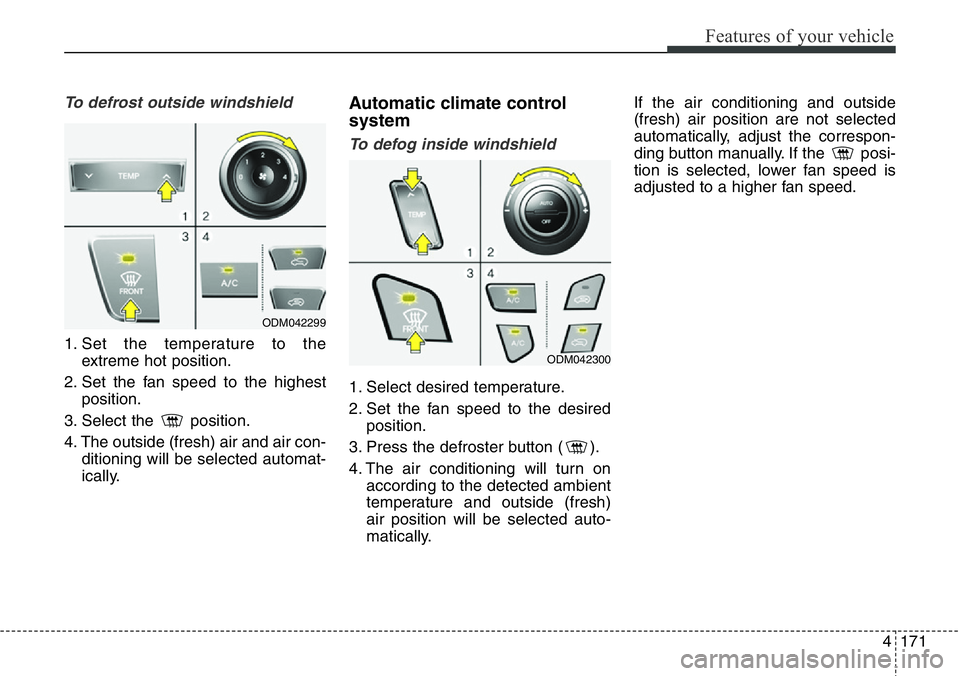
4171
Features of your vehicle
To defrost outside windshield
1. Set the temperature to the
extreme hot position.
2. Set the fan speed to the highest
position.
3. Select the position.
4. The outside (fresh) air and air con-
ditioning will be selected automat-
ically.
Automatic climate control
system
To defog inside windshield
1. Select desired temperature.
2. Set the fan speed to the desired
position.
3. Press the defroster button ( ).
4. The air conditioning will turn on
according to the detected ambient
temperature and outside (fresh)
air position will be selected auto-
matically.If the air conditioning and outside
(fresh) air position are not selected
automatically, adjust the correspon-
ding button manually. If the posi-
tion is selected, lower fan speed is
adjusted to a higher fan speed.
ODM042299
ODM042300
Page 273 of 711
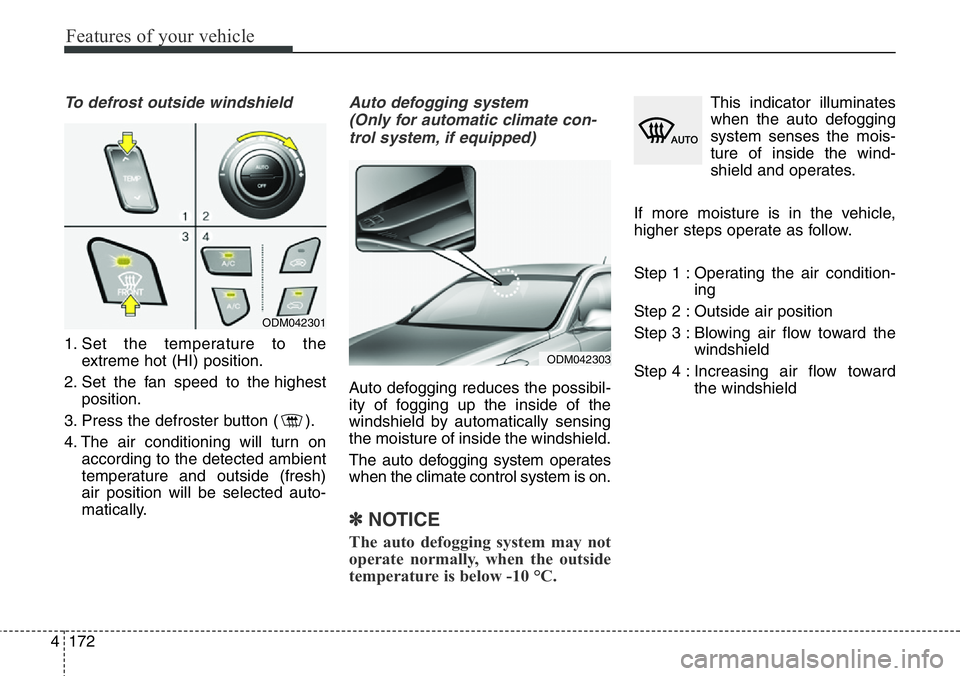
Features of your vehicle
172 4
To defrost outside windshield
1. Set the temperature to the
extreme hot (HI) position.
2. Set the fan speed to the highest
position.
3. Press the defroster button ( ).
4. The air conditioning will turn on
according to the detected ambient
temperature and outside (fresh)
air position will be selected auto-
matically.
Auto defogging system
(Only for automatic climate con-
trol system, if equipped)
Auto defogging reduces the possibil-
ity of fogging up the inside of the
windshield by automatically sensing
the moisture of inside the windshield.
The auto defogging system operates
when the climate control system is on.
✽NOTICE
The auto defogging system may not
operate normally, when the outside
temperature is below -10 °C.
This indicator illuminates
when the auto defogging
system senses the mois-
ture of inside the wind-
shield and operates.
If more moisture is in the vehicle,
higher steps operate as follow.
Step 1 : Operating the air condition-
ing
Step 2 : Outside air position
Step 3 : Blowing air flow toward the
windshield
Step 4 : Increasing air flow toward
the windshield
ODM042301
ODM042303
Page 487 of 711
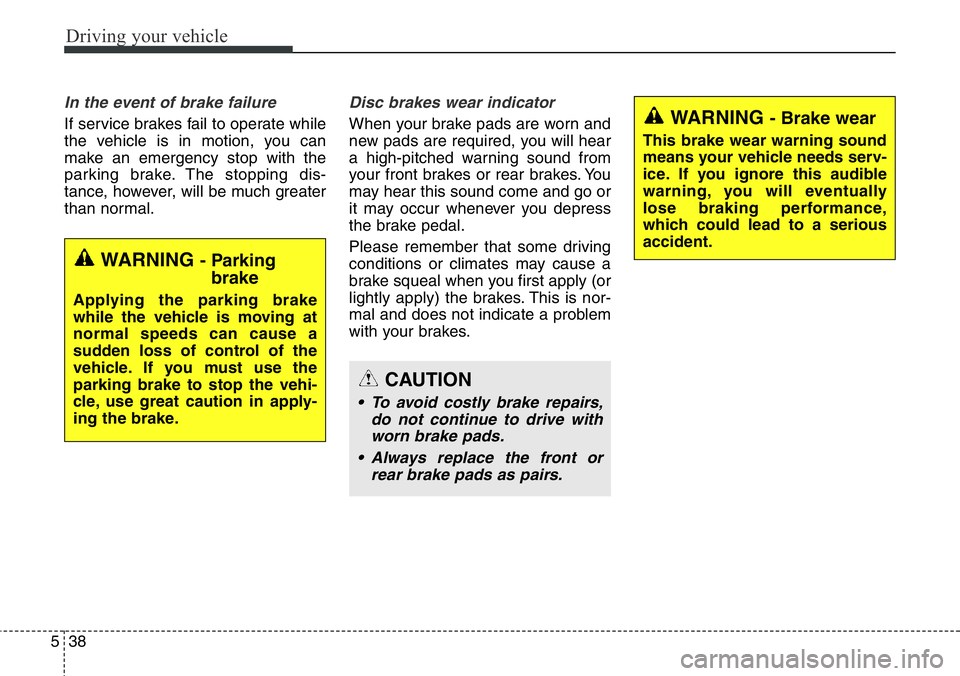
Driving your vehicle
38 5
In the event of brake failure
If service brakes fail to operate while
the vehicle is in motion, you can
make an emergency stop with the
parking brake. The stopping dis-
tance, however, will be much greater
than normal.
Disc brakes wear indicator
When your brake pads are worn and
new pads are required, you will hear
a high-pitched warning sound from
your front brakes or rear brakes. You
may hear this sound come and go or
it may occur whenever you depress
the brake pedal.
Please remember that some driving
conditions or climates may cause a
brake squeal when you first apply (or
lightly apply) the brakes. This is nor-
mal and does not indicate a problem
with your brakes.
WARNING - Parking
brake
Applying the parking brake
while the vehicle is moving at
normal speeds can cause a
sudden loss of control of the
vehicle. If you must use the
parking brake to stop the vehi-
cle, use great caution in apply-
ing the brake.
WARNING - Brake wear
This brake wear warning sound
means your vehicle needs serv-
ice. If you ignore this audible
warning, you will eventually
lose braking performance,
which could lead to a serious
accident.
CAUTION
• To avoid costly brake repairs,
do not continue to drive with
worn brake pads.
• Always replace the front or
rear brake pads as pairs.
Page 586 of 711
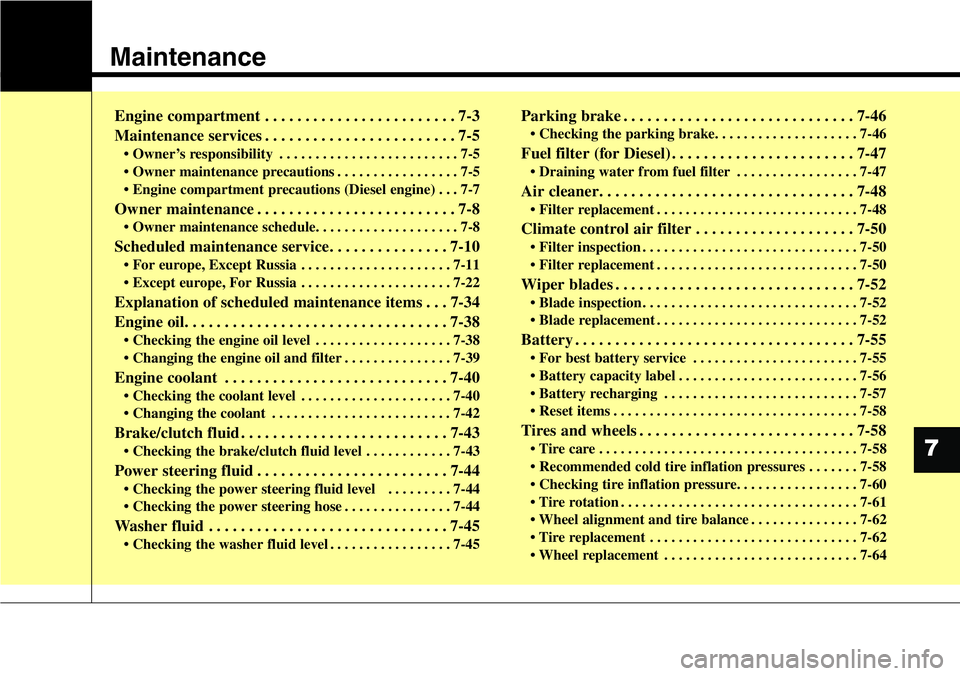
Maintenance
7
Engine compartment . . . . . . . . . . . . . . . . . . . . . . . . 7-3
Maintenance services . . . . . . . . . . . . . . . . . . . . . . . . 7-5
• Owner’s responsibility . . . . . . . . . . . . . . . . . . . . . . . . . 7-5
• Owner maintenance precautions . . . . . . . . . . . . . . . . . 7-5
• Engine compartment precautions (Diesel engine) . . . 7-7
Owner maintenance . . . . . . . . . . . . . . . . . . . . . . . . . 7-8
• Owner maintenance schedule. . . . . . . . . . . . . . . . . . . . 7-8
Scheduled maintenance service. . . . . . . . . . . . . . . 7-10
• For europe, Except Russia . . . . . . . . . . . . . . . . . . . . . 7-11
• Except europe, For Russia . . . . . . . . . . . . . . . . . . . . . 7-22
Explanation of scheduled maintenance items . . . 7-34
Engine oil. . . . . . . . . . . . . . . . . . . . . . . . . . . . . . . . . 7-38
• Checking the engine oil level . . . . . . . . . . . . . . . . . . . 7-38
• Changing the engine oil and filter . . . . . . . . . . . . . . . 7-39
Engine coolant . . . . . . . . . . . . . . . . . . . . . . . . . . . . 7-40
• Checking the coolant level . . . . . . . . . . . . . . . . . . . . . 7-40
• Changing the coolant . . . . . . . . . . . . . . . . . . . . . . . . . 7-42
Brake/clutch fluid . . . . . . . . . . . . . . . . . . . . . . . . . . 7-43
• Checking the brake/clutch fluid level . . . . . . . . . . . . 7-43
Power steering fluid . . . . . . . . . . . . . . . . . . . . . . . . 7-44
• Checking the power steering fluid level . . . . . . . . . 7-44
• Checking the power steering hose . . . . . . . . . . . . . . . 7-44
Washer fluid . . . . . . . . . . . . . . . . . . . . . . . . . . . . . . 7-45
• Checking the washer fluid level . . . . . . . . . . . . . . . . . 7-45
Parking brake . . . . . . . . . . . . . . . . . . . . . . . . . . . . . 7-46
• Checking the parking brake. . . . . . . . . . . . . . . . . . . . 7-46
Fuel filter (for Diesel) . . . . . . . . . . . . . . . . . . . . . . . 7-47
• Draining water from fuel filter . . . . . . . . . . . . . . . . . 7-47
Air cleaner. . . . . . . . . . . . . . . . . . . . . . . . . . . . . . . . 7-48
• Filter replacement . . . . . . . . . . . . . . . . . . . . . . . . . . . . 7-48
Climate control air filter . . . . . . . . . . . . . . . . . . . . 7-50
• Filter inspection . . . . . . . . . . . . . . . . . . . . . . . . . . . . . . 7-50
• Filter replacement . . . . . . . . . . . . . . . . . . . . . . . . . . . . 7-50
Wiper blades . . . . . . . . . . . . . . . . . . . . . . . . . . . . . . 7-52
• Blade inspection . . . . . . . . . . . . . . . . . . . . . . . . . . . . . . 7-52
• Blade replacement . . . . . . . . . . . . . . . . . . . . . . . . . . . . 7-52
Battery . . . . . . . . . . . . . . . . . . . . . . . . . . . . . . . . . . . 7-55
• For best battery service . . . . . . . . . . . . . . . . . . . . . . . 7-55
• Battery capacity label . . . . . . . . . . . . . . . . . . . . . . . . . 7-56
• Battery recharging . . . . . . . . . . . . . . . . . . . . . . . . . . . 7-57
• Reset items . . . . . . . . . . . . . . . . . . . . . . . . . . . . . . . . . . 7-58
Tires and wheels . . . . . . . . . . . . . . . . . . . . . . . . . . . 7-58
• Tire care . . . . . . . . . . . . . . . . . . . . . . . . . . . . . . . . . . . . 7-58
• Recommended cold tire inflation pressures . . . . . . . 7-58
• Checking tire inflation pressure. . . . . . . . . . . . . . . . . 7-60
• Tire rotation . . . . . . . . . . . . . . . . . . . . . . . . . . . . . . . . . 7-61
• Wheel alignment and tire balance . . . . . . . . . . . . . . . 7-62
• Tire replacement . . . . . . . . . . . . . . . . . . . . . . . . . . . . . 7-62
• Wheel replacement . . . . . . . . . . . . . . . . . . . . . . . . . . . 7-64
Page 597 of 711

Maintenance
12 7
NORMAL MAINTENANCE SCHEDULE - FOR EUROPE, EXCEPT RUSSIA (CONT.)
30,000 km (20,000 miles) or 24 months
❑ Inspect air cleaner filter
❑ Inspect air conditioner refrigerant/compressor (if equipped)
❑ Inspect battery condition
❑ Inspect brake lines, hoses and connections
❑ Inspect all electrical system
❑ Inspect disc brakes and pads
❑ Inspect drive shafts and boots
❑ Inspect exhaust system
❑ Inspect front suspension ball joints
❑ Inspect fuel filter cartridge (Diesel) *
6
❑ Inspect fuel lines, fuel hoses and connections (Diesel)
❑ Inspect parking brake (Foot/Hand type)
❑ Inspect power steering fluid and hoses (if equipped)
❑ Inspect propeller shaft (if equipped)
❑ Inspect steering gear rack, linkage and boots
❑ Inspect tire (pressure & tread wear)
❑ Inspect vacuum hose (for EGR & throttle body)
(Gasoline)
❑ Replace brake/clutch(if equipped) fluid
❑ Replace climate control air filter
❑ Replace engine oil and filter (Diesel - R) *
1 *2 *3*5
(Continued)
(Continued)
❑ Replace engine oil and filter (Gasoline - theta) *1 *4 *5
❑ Add fuel additives (Gasoline) *12
(Every 15,000 km or 12months)
❈Inspect : Inspect and if necessary, adjust, correct, clean or
replace.